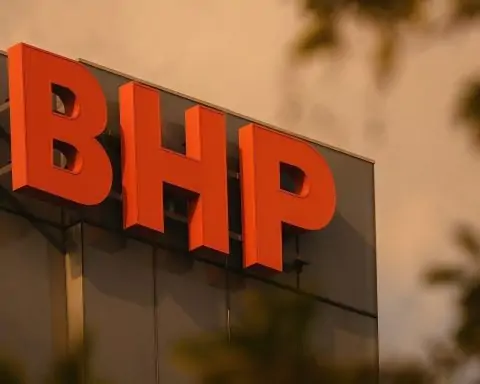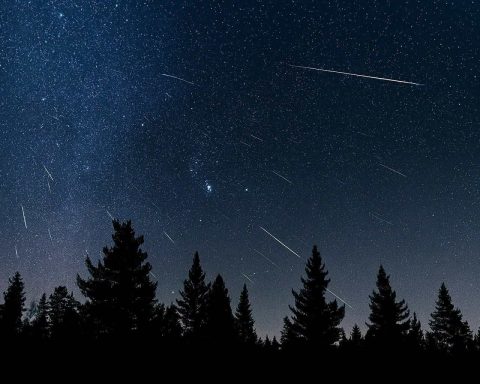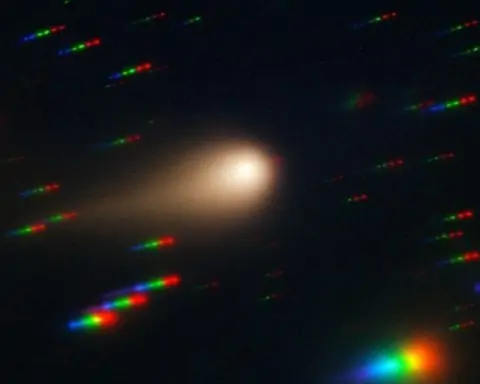- The Orion Stage Adapter for Artemis II was completed at NASA’s Marshall Space Flight Center and will ship to Kennedy Space Center, with Artemis II planned as a 10-day crewed lunar trip around the Moon by April 2026.
- NASA announced Phase 2 of its LunaRecycle challenge offering up to $2 million in prizes to prototype recycling systems for a lunar base, with finalists demonstrating their tech in August 2026.
- NASA awarded a $3.6 billion contract to KBR Wyle Services LLC to support astronaut health and performance research through 2035, covering programs at Johnson Space Center from the ISS to Artemis.
- NASA confirmed the Lunar Trailblazer mission ended after the small lunar orbiter failed to reach the Moon, launched in February to map lunar water ice and declared over on July 31 due to misaligned solar arrays.
- Blue Origin resumed space tourism with the NS-34 flight on August 3, carrying six civilian passengers to the edge of space above West Texas for a few minutes of weightlessness beyond 100 km.
- SpaceX notched its 100th launch of 2025 on August 11, performing two orbital launches in one day from Florida and California.
- On August 11 SpaceX launched 24 Kuiper satellites on a Falcon 9 (Kuiper Flight 02) and later launched Starlink satellites from Vandenberg, bringing Starlink to over 4,500 in orbit and Kuiper to 102.
- Rocket Lab’s Electron mission on August 5 deployed the Japanese radar imaging satellite QPS-SAR-12 for iQPS on the “The Harvest Goddess Thrives” mission, marking the 11th successful mission of 2025 and keeping Neutron’s first flight on track for year-end.
- United Launch Alliance’s Vulcan Centaur is set for its first U.S. national security launch with USSF-106 on August 12 from Cape Canaveral’s SLC-41, delivering two GEO satellites and marking Vulcan’s third launch after years of BE-4 delays.
- Europe’s Ariane 6, using the Ariane 62 variant, is scheduled to launch from Kourou on the night of August 12–13 carrying MetOp-SG A1 and Copernicus Sentinel-5P, the third Ariane 6 test flight as Europe regains an independent launch cadence, with liftoff around 8:37 pm EDT.
NASA & Government Space Agency Highlights
Artemis II Moon Mission Hardware Unveiled: NASA gave a sneak peek at the last major piece of its Artemis II Moon mission rocket. Media were invited to see the Orion Stage Adapter – a ring connecting the SLS rocket’s upper stage to the Orion spacecraft – at Marshall Space Flight Center on Aug. 14 before it ships to Kennedy Space Center [1]. With this adapter complete, all components of the SLS for Artemis II are now built and nearly stacked, as the mission gears up for a 10-day crewed trip around the Moon by April 2026 [2]. This marks NASA’s first crewed lunar mission of the Artemis era, intended to lay the groundwork for future Moon landings and eventually Mars missions [3] [4].
Pushing Space Sustainability: NASA also launched the second phase of its “LunaRecycle” challenge – a competition to develop ways of recycling trash for long-term Moon missions [5]. Phase 2 invites U.S. innovators to prototype systems that can repurpose common waste (like packaging, fabrics, plastics, and metal) generated by astronauts living on a lunar base [6]. “NASA is eager to see how reimagining these materials can be helpful to future planetary surface missions,” said Jennifer Edmunson, acting program manager for NASA’s Centennial Challenges, adding that focusing on critical trash items “will yield remarkable solutions that could enable a sustainable human presence off-Earth and transform the future of space exploration” [7]. Up to $2 million in prizes is on the line, and finalists will demonstrate their recycling tech in August 2026 [8] [9].
Astronaut Health Investment: In related news, NASA awarded a $3.6 billion contract to KBR Wyle Services LLC to support astronaut health and performance research through 2035 [10]. The contract covers services for programs at Johnson Space Center – from the ISS and Commercial Crew flights to Artemis – ensuring astronaut medical care, occupational health, and safety measures are in place for future long-duration missions [11] [12]. This major award underlines NASA’s commitment to keeping crews healthy as humanity prepares to venture farther into space.
Lunar Trailblazer Mission Loss: On a sobering note, NASA confirmed it has ended the Lunar Trailblazer mission after the small lunar orbiter failed to reach the Moon [13]. The briefcase-sized satellite launched in February to map lunar water ice, but lost contact one day after launch – its solar arrays were misaligned and couldn’t charge the batteries, leaving it adrift in deep space [14] [15]. Teams spent months listening for a signal and tracking the craft’s slow spin away from the Moon, but ultimately declared the mission over on July 31. “At NASA, we undertake high-risk, high-reward missions like Lunar Trailblazer to find revolutionary ways of doing new science,” said Dr. Nicky Fox, NASA’s science chief. “While it was not the outcome we’d hoped for, mission experiences like Lunar Trailblazer help us learn and reduce risk for future low-cost small satellites… as we prepare for a sustained human presence on the Moon” [16]. Despite the disappointment, NASA noted the technology developed for Lunar Trailblazer – including new water-mapping spectrometers – will live on in upcoming missions [17].
Commercial Spaceflight Developments
Blue Origin Resumes Space Tourism:Blue Origin is back in the suborbital tourism game. On August 3, Jeff Bezos’ company launched its first crewed New Shepard flight in nearly a year, carrying six civilian passengers (including a crypto billionaire) to the edge of space and back [18]. The NS-34 mission lifted off from West Texas, shooting past 100 km altitude for a few minutes of weightlessness before a parachute landing [19]. “It was an honor to see so many nations represented on our flight today,” Blue Origin VP Phil Joyce said afterward, noting the unifying effect of seeing “our fragile planet” from space [20]. This successful outing – with tourists from multiple countries – marks a rebound for Blue Origin’s space tourism program, which had been on hold since a 2022 booster anomaly [21]. The company is expected to ramp up a regular cadence of suborbital trips as it restores confidence in New Shepard’s reliability.
SpaceX’s Record-Breaking Launch Pace:SpaceX’s launch cadence in 2025 is nothing short of astronomical. The company notched its 100th launch of the year on Aug. 11, far ahead of last year’s record (138 launches) [22]. In fact, SpaceX pulled off two orbital launches on the same day: one from Florida in the morning and another from California by night. This relentless pace – lofting batches of Starlink internet satellites and customer payloads weekly – underscores how commercial launch activity is booming. Industry analysts note that just a few years ago 100 launches in a year globally would be remarkable; now a single company is on track to shatter that benchmark [23]. The milestone reflects SpaceX’s unique model of reusable rockets and high demand for its launch services, both for its own Starlink mega-constellation and for clients like NASA, the Pentagon, and even competitors (such as Amazon’s Kuiper). With multiple Falcon 9 boosters flying frequently and Starship test flights in the mix, SpaceX has dramatically lowered the cost of access to orbit, fueling a surge in satellite deployments and ambitious space projects.
Rocket Lab’s Steady Rise: Small-launch specialist Rocket Lab continues to quietly make history of its own. The company achieved its 11th successful mission of 2025 this week, maintaining a 100% success rate this year [24]. On August 5 (NZT), an Electron rocket launched from New Zealand, deploying a Japanese radar imaging satellite (“QPS-SAR-12” for startup iQPS) into orbit [25]. The whimsically named “The Harvest Goddess Thrives” mission keeps Rocket Lab on a record pace and on track to debut its larger Neutron rocket by late 2025 [26]. Company executives report that Neutron’s development is on a “green light” path with almost no schedule margin, aiming for a first flight by year’s end [27]. If successful, Neutron will significantly boost Rocket Lab’s payload capacity, allowing it to challenge larger launch providers. For now, Rocket Lab’s reliable Electron launches (already 11 in eight months) solidify its position as a leading player in the burgeoning smallsat launch market.
Satellite Launches & New Missions
Historic Vulcan Rocket Debut: A major milestone in rocketry is set for this week as United Launch Alliance (ULA) prepares to launch its brand-new Vulcan Centaur rocket on August 12. Flight USSF-106 will mark Vulcan’s first national security launch for the U.S. Space Force [28]. Rolling out at Cape Canaveral’s Pad SLC-41, the heavy-lift Vulcan is tasked with delivering two military satellites directly into geosynchronous orbit – a challenging, long-duration mission that tests Vulcan’s capabilities [29]. ULA CEO Tory Bruno hailed the mission as “what we designed this rocket to do,” emphasizing that Vulcan was built for exactly these demanding trajectories [30]. This launch is only the third ever for Vulcan (which is still in its early test phase) and comes after years of development delays involving its BE-4 engines and payload readiness [31]. The primary payload, the Navigation Technology Satellite-3 (NTS-3), is a cutting-edge experimental navigation satellite – the first of its kind in nearly 50 years – meant to enhance GPS by testing new anti-jamming technologies [32] [33]. Managed by the Air Force Research Lab, NTS-3 can be reprogrammed on the fly to respond to threats, representing a leap forward in secure positioning systems [34]. If all goes well at the 7:59 pm EDT liftoff on Tuesday, it will not only validate ULA’s next-gen rocket but also inaugurate a new era of U.S. launch vehicles after the retirement of Atlas V. Weather forecasts are ~75% favorable for the evening launch [35], and ULA is already looking ahead – Bruno noted the company has a “stockpile” of Vulcans and remaining Atlas rockets ready, aiming for two launches per month by early 2026 to stay competitive [36].
Europe’s Ariane 6 Poised for Launch: Across the Atlantic, Europe is about to fire up its own next-generation launcher. A heavy-lift Ariane 6 (Ariane 62 variant) is scheduled for launch from Kourou, French Guiana on the night of Aug. 12–13 [37]. This mission carries two major European satellites: MetOp-SG A1, a next-generation weather satellite for EUMETSAT, and Copernicus Sentinel-5P (Precursor), an Earth observation satellite focused on atmospheric monitoring [38]. MetOp-SG A1, about the size of a small truck (~4,000 kg), is the first in a series that will provide improved weather forecasting and climate data through 2040 [39]. The launch will be the third test flight of Ariane 6, as Europe works to certify this Ariane 5 successor for operational use [40]. A successful outing would be a pivotal step in Europe’s transition to Ariane 6 and help regain an independent launch cadence after a gap in launches. ESA officials are keen to demonstrate Ariane 6’s reliability soon, as Europe has faced a backlog of satellites (including Galileo navigation sats and scientific probes) awaiting rides to orbit since Ariane 5’s retirement and delays with Ariane 6 development. Liftoff is slated for ~8:37 pm EDT (00:37 UTC), just minutes after ULA’s Vulcan, making Tuesday night a thrilling showcase of new rockets on both sides of the ocean [41].
SpaceX Launches Starlinks and Amazon’s Kuipers: Not to be outdone, SpaceX executed a launch double-header on Aug. 11, underscoring the frenetic pace of satellite deployments. Early Monday, a Falcon 9 rocket from Florida’s Cape Canaveral lofted 24 of Amazon’s Project Kuiper broadband satellites – the second batch of this planned megaconstellation (and a direct competitor to SpaceX’s own Starlink) [42]. After three days of weather and technical scrubs, the Falcon 9 finally roared skyward at 8:35 am EDT, deploying the Kuiper satellites into low-Earth orbit [43]. This mission (Kuiper Flight 02) marked SpaceX’s 100th launch of 2025 [44] – a staggering achievement by mid-year – and brings Amazon’s total satellites in orbit to 102 so far [45]. Each Kuiper satellite will join Amazon’s nascent network to deliver global internet coverage in coming years, an effort Amazon is fast-tracking with launches on both SpaceX and ULA rockets. Then late the same night, SpaceX turned around and launched another Falcon 9 from Vandenberg Space Force Base in California, carrying a group of its own Starlink internet satellites to orbit [46]. This west-coast Starlink flight had been delayed from the weekend but finally lifted off around 11:44 pm EDT on Aug. 11 (8:44 pm local time) once winds and schedules cleared [47]. With Starlink Group 17-4 in orbit, SpaceX continues to expand the world’s largest satellite constellation, now over 4,500 strong, providing broadband to hundreds of thousands of users. The back-to-back launches in under 18 hours highlight SpaceX’s routine operational tempo – an unprecedented feat in aerospace. It also showcased a rare instance of SpaceX launching a rival’s satellites: Amazon’s Kuipers hitching a ride on a Falcon 9, reflecting the pragmatic cooperation emerging even between competitors in the booming commercial space sector.
Other Notable Launches:Japan’s iQPS satellite wasn’t the only international payload riding to orbit recently. In addition to Rocket Lab’s mission mentioned above, China’s space program has maintained a high tempo. Just last week, a Chinese Long March rocket from Wenchang launched a “SatNet LEO Group 07” batch of satellites – believed to be part of China’s new low-Earth orbit internet constellation – while another Chinese Jielong-3 sea launch deployed 11 satellites for Geely’s commercial IoT constellation in a single mission [48]. These launches, though occurring just outside the Aug 11–12 window, underline the global flurry of satellite deployment activity. From mega-constellations for broadband to Earth observation and navigation experiments, the first half of August has seen a remarkable diversity of missions take flight. All told, the week of Aug 7–13 features at least half a dozen launches worldwide, and even more are queued up: looking ahead, SpaceX is preparing yet another Starlink launch later this week, and China plans a significant Long March 5B launch in the coming days [49]. It’s clear the “rocket renaissance” of the 2020s is in full swing, with new boosters and satellites lifting off almost daily.
Astronomical Discoveries & Events
Perseid Meteor Shower Dazzles (Despite Moonlight): One of the year’s most anticipated sky shows – the Perseid meteor shower – is peaking on the nights of August 12–13. The Perseids occur each summer as Earth plows through dust left by Comet Swift-Tuttle, and they often produce abundant “shooting stars” streaking from the constellation Perseus. This year, however, skywatchers have a mixed forecast: in ideal dark-sky conditions, up to 100 meteors per hour might be visible at the shower’s pre-dawn peak on Aug. 13 [50]. But unfortunately, a bright 86%-full waning gibbous Moon is rising late at night, washing out many of the fainter meteors [51] [52]. Experts predict the glare will reduce visible rates dramatically – possibly to only 10–20 meteors per hour in most areas. “The best rates will probably be near 15 per hour as dim meteors make up a majority of the activity,” Robert Lunsford of the American Meteor Society told Space.com [53]. Still, the Perseids are famous for their bright fireballs, so even a few could be spectacular. Enthusiasts are advised to watch after midnight with the Moon at their back, and focus on the northeastern sky. Despite the lunar interference, any Perseid meteor that does appear could be long and eye-catching – the Perseids are known for fast, vivid streaks often leaving lingering trails. And as always, patience is key: give your eyes time to adapt to the dark, and you just might catch a brilliant fragment of comet dust burning up in Earth’s atmosphere.
New Cosmic Revelations: The past few days also brought exciting news on the astronomical discovery front. Scientists using NASA’s James Webb Space Telescope announced evidence of a possible exoplanet orbiting the closest solar twin to Earth – that is, the nearest star that closely matches our Sun [54]. This finding (detected via subtle dips in starlight observed by Webb) has generated buzz as it could reveal clues about planetary formation around Sun-like stars in our cosmic neighborhood. In another visual treat, NASA’s Hubble Telescope released a stunning new image of the Tarantula Nebula – a massive star-forming region in the nearby Large Magellanic Cloud galaxy [55]. The razor-sharp Hubble view shows intricate gas filaments and young star clusters in this “cosmic spider web,” captivating astronomers and the public alike. These developments come alongside reports that solar researchers have produced a new 3D visualization of one of the most powerful solar storms on record [56], helping scientists better understand how colossal coronal mass ejections propagate through space. From distant exoplanets to our own Sun’s fury, our understanding of the universe continues to expand daily. As NASA often reminds us, every week brings new wonders: whether peering billions of light-years out or watching celestial fireworks in our own skies, there’s always something amazing for space fans to witness.
Space Policy & International Collaboration
U.S. and Europe Boost Space Security: Recent days saw significant moves on the space policy front, especially relating to defense and regulation. In the United States, the Department of Defense appointed a new “space czar” to oversee the “Golden Dome” project – an initiative aimed at improving U.S. missile-warning and space defense capabilities [57]. At the same time, the Pentagon signaled it is seeking additional launch providers for its Space Force missions beyond the usual two (SpaceX and ULA) [58]. This suggests greater opening of military launch contracts to emerging players, ensuring the U.S. military has robust access to orbit even as launch demand grows. Meanwhile in Europe, the European Commission unveiled a draft EU Space Act this week, proposing the first unified legal framework for space activities across EU member states [59]. The draft act covers common rules for authorizing launches, managing satellites, mitigating debris, and other space governance issues. Its release comes as European space spending has hit all-time highs, driven in part by increased defense investment [60]. The EU Space Act is open for consultation and reflects Europe’s resolve to streamline oversight of both civil and commercial space ventures. Analysts see it as a bold step toward ensuring Europe remains competitive and harmonizing regulations in an era when many nations and companies are racing to space. Together, these U.S. and EU developments show how geopolitics and security concerns are shaping space policy – from fortifying satellite networks against threats to crafting new laws for the final frontier.
NASA–Roscosmos Cooperation Endures: In spite of tensions on Earth, space diplomacy got a boost with news of continued U.S.–Russian cooperation aboard the International Space Station. Roscosmos chief Dmitry Bakanov visited the U.S. in early August – the first head of Russia’s space agency to meet NASA leadership in America in 8 years – and the talks were surprisingly productive [61]. NASA announced that it has extended its “seat swap” agreement with Roscosmos through 2027, meaning American astronauts will keep riding Russian Soyuz vehicles and Russian cosmonauts will fly on U.S. Crew Dragon missions on a rotating basis [62]. This ensures both nations always have crew members on the ISS, sharing access in case either side’s spacecraft has issues. “We did have a good exchange between the two agencies and our cooperation is continuing on ISS,” Dina Contella, NASA’s ISS deputy program manager, noted after the meetings [63]. She confirmed that the partners agreed in principle to operate the ISS together until 2028 and even discussed the station’s eventual controlled deorbit by 2030 [64]. This reaffirmation comes despite the war-driven strain in U.S.–Russia relations; it underscores that, above the atmosphere, pragmatism prevails. Both NASA and Roscosmos remain committed to a safe, functional ISS in the coming years. The extension buys time as NASA works with other international partners on a future commercial space station and as Russia considers its own post-ISS plans. For now, at least, the iconic orbital lab continues to be a venue of peaceful collaboration. As one NASA official put it, “space has a unique way of bringing nations together”, and the latest agreements show that even in a divided world, astronauts and cosmonauts will keep living and working side by side in orbit [65].
Conclusion: From hardware milestones in the Moon race to a blitz of satellite launches, and from dazzling celestial events to earthly policies shaping the future of space, the past 48 hours have been extraordinarily eventful. It’s a thrilling time for space enthusiasts – governments and companies alike are pushing boundaries, breaking records, and chasing the next giant leap. As we watch Artemis hardware being readied, rockets roaring skyward, and meteors lighting up the night, one thing is clear: the new space age is in full swing. Each development, whether technological, scientific, or diplomatic, is another piece of a rapidly unfolding story – one that promises to take humanity farther and teach us more, on all fronts of the final frontier [66] [67].
Sources: NASA News Releases [68] [69] [70] [71] [72] [73]; Space.com & ScienceDaily [74] [75] [76]; SpacePolicyOnline [77] [78]; Astronomy Magazine [79] [80]; TS2 Space News Roundup [81] [82] [83]; NASASpaceflight [84] [85]; EarthSky & NASA Science Highlights [86] [87].
References
1. www.nasa.gov, 2. www.nasa.gov, 3. www.nasa.gov, 4. www.nasa.gov, 5. www.nasa.gov, 6. www.nasa.gov, 7. www.nasa.gov, 8. www.nasa.gov, 9. www.nasa.gov, 10. www.nasa.gov, 11. www.nasa.gov, 12. www.nasa.gov, 13. www.sciencedaily.com, 14. www.sciencedaily.com, 15. www.sciencedaily.com, 16. www.sciencedaily.com, 17. www.sciencedaily.com, 18. ts2.tech, 19. ts2.tech, 20. ts2.tech, 21. ts2.tech, 22. ts2.tech, 23. ts2.tech, 24. ts2.tech, 25. ts2.tech, 26. ts2.tech, 27. ts2.tech, 28. ts2.tech, 29. ts2.tech, 30. ts2.tech, 31. ts2.tech, 32. www.astronomy.com, 33. www.astronomy.com, 34. www.astronomy.com, 35. spacepolicyonline.com, 36. ts2.tech, 37. ts2.tech, 38. ts2.tech, 39. ts2.tech, 40. ts2.tech, 41. www.astronomy.com, 42. ts2.tech, 43. ts2.tech, 44. ts2.tech, 45. ts2.tech, 46. ts2.tech, 47. ts2.tech, 48. www.astronomy.com, 49. www.astronomy.com, 50. www.space.com, 51. www.space.com, 52. www.space.com, 53. www.space.com, 54. www.nasa.gov, 55. www.nasa.gov, 56. earthsky.org, 57. www.jdsupra.com, 58. www.jdsupra.com, 59. www.jdsupra.com, 60. www.jdsupra.com, 61. ts2.tech, 62. ts2.tech, 63. ts2.tech, 64. ts2.tech, 65. ts2.tech, 66. spacepolicyonline.com, 67. www.sciencedaily.com, 68. www.nasa.gov, 69. www.nasa.gov, 70. www.nasa.gov, 71. www.nasa.gov, 72. www.sciencedaily.com, 73. www.sciencedaily.com, 74. www.space.com, 75. www.space.com, 76. www.sciencedaily.com, 77. spacepolicyonline.com, 78. ts2.tech, 79. www.astronomy.com, 80. www.astronomy.com, 81. ts2.tech, 82. ts2.tech, 83. ts2.tech, 84. ts2.tech, 85. www.nasaspaceflight.com, 86. www.nasa.gov, 87. www.youtube.com










